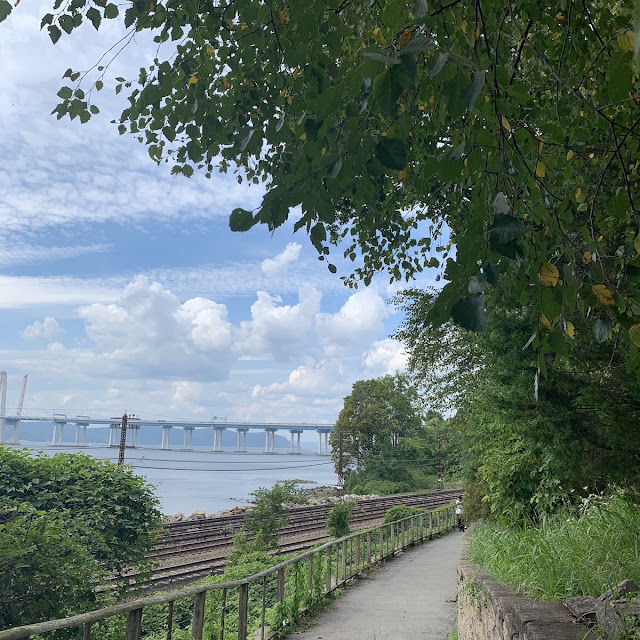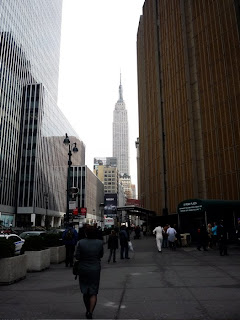In Washington Irving Country: A Walk Between Irvington and Tarrytown on the Old Croton Aqueduct Trail
A stroll in the countryside may be slow and rhythmic, accompanied by a soft breeze among the trees, but walking in this sleepy fashion doesn’t mean the brain is not alert. This pace is especially true for a walk in Washington Irving country about thirty miles north of New York City along the Hudson River.
 |
| Rip Van Winkle sculpture (detail) by Richard Masloski. Main Street, Irvington, New York. |
Up near Irvington and Tarrytown, just south of Sleepy Hollow, a steady yet alert pace is recommended, taking in whatever happens as the walk progresses. Walking along the Old Croton Aqueduct Trail and going off the trail in whims and reveries can awaken the imagination, especially for overactive imaginations primed for the pump. You don’t want to get too sleepy near Sleepy Hollow.
 |
| Rip, with a view of Irvington Town Hall |
When I mentioned to an acquaintance not long ago that I had been exploring the woods south of Sleepy Hollow, this person affirmed with great conviction that this land was truly haunted. She said, “It suddenly gets cold and dark in the hollow.” As a child raised on the tales of the Headless Horseman and Sleepy Hollow, I was ready and willing to believe her. On one previous exploration of this area, somewhere near a bend in a river trail, I suddenly felt the atmosphere change as she described, something ineffably chilly but exciting.
 |
| Old Croton Aqueduct Trail near downtown Irvington, with contemporary signage |
For those raised on Washington Irving’s tales, we tend to associate the Knickerbocker writer and his Hudson River landscape with autumn, the time of golden dying leaves, pumpkins and ghosts. Yet, beginning in middle to late August, the quality of light changes, enough to set the seasonal wheels in motion. On the periphery of our familiar eyesight, especially through eyes accustomed and alert to the visual circumstances of the large metropolis, Nature can play tricks. On a walk in the woods on the Old Croton Aqueduct Trail this past Saturday, I came across a white-tailed deer. I spent a minute in a startled state, as I am not accustomed to meeting such creatures, and the two of us spent the next five minutes playing that deer in the headlights routine.
 |
| Entrance to Sunnyside. W. Sunnyside Lane. |
A walk along the Old Croton Aqueduct Trail, a 26.2-mile trail that extends from the Bronx up through Westchester County, may provide a bucolic escape from the pandemic, but the story here is about the legacy of previous pandemics. In the early decades of the nineteenth century, a rapidly growing New York overran its supply of fresh water, and its wells and streams became polluted in the process. Devastating epidemics of yellow fever and cholera followed.
 |
| View of the Hudson River from Sunnyside |
The city of opportunity needed a new supply for water. Beginning in the 1830s, West Point engineers devised a system of providing fresh water to New York City through an intricate system of aqueducts that would flow downhill from the newly damned Croton River to receiving reservoirs in what is now Central Park. Smartly devised with a succession of ventilating towers, wiers, and culverts the flowing water would breathe new life in the city.
In 1832, after living abroad for seventeen years, Washington Irving returned to the United States. Already an established author, famous for his tales of Rip Van Winkle and The Legend of Sleepy Hollow, in 1835 he bought a small cottage and land on the river in Tarrytown, New York in close proximity to the new system. He hired an architect to enlarge his Romantic vision, with Dutch and country details.
 |
| Back on the trail near Sunnyside |
The Aqueduct opened on June 22, 1842, with its water flowing to the city. Before the opening, Irving reluctantly left Sunnyside for an appointment as Minister of Spain in President John Tyler’s administration. He would return to his Tarrytown estate four years later in September 1846.
 |
| A white-tailed deer near the trail |
Walking the Old Croton Aqueduct Trail through Washington Irving Country from Irvington to Tarrytown brings two sensibilities together. One is imaginative and romantic, firmly rooted in nature, and the other is scientific and engineered - nature tamed. Visiting the author’s Sunnyside estate requires leaving the trail and walking a few blocks west. The detour is worth the extra steps, even without the commitment to touring the grounds with a ticket. That deep dive in Sunnyside is for another day. Just a glimpse of the Hudson River reconnects the adventure on foot to the river landscape that lured Irving and other residents to these shores.
 |
| Sign for the River Walk |
North of Sunnyside Lane, the trail enters deep woods. Be on the lookout for white-tailed deer, especially one that likes to stare. Look also for a crossroads, and a sign marking the Westchester River Walk. Either take the river walk or continue on the aqueduct trail north, because both trails lead to one of the most beautiful houses in New York State.
 |
| Lyndhurst |
If the walk already feels like a dreamy walk in the English countryside, the appearance of Lyndhurst on the great hill ahead can feel like a hallucination. Is this Downtown Abbey? Brideshead? Actually there are many great estates and mansions along the Hudson River, but Lyndhurst is exceptionally beautiful. Alexander Jackson Davis designed the Gothic Revival masterpiece in 1838 for New York City mayor William Paulding, Jr., one of Washington Irving’s close friends. The architect expanded the design for the subsequent owner, George Merritt. In 1880 tycoon Jay Gould bought the house to use as his country place.
 |
| The grounds of Lyndhurst |
The surrounding park is filled with specimen trees and a conservatory. On Saturday, visitors to the 67-acre grounds sprawled out on picnic blankets or sat under the cool shade of the tall linden trees, elms, and willows. The River Walk leads directly to the sloping grounds overlooking the Hudson River, while the Old Croton Aqueduct Trail veers off to the east near the Welcome Center. Those arriving on foot either way have direct access to the grounds without having to pay for the day pass required for vehicle entry.
 |
| Leaving Lyndhurst |
Basking in the sunshine on the Lyndhurst Mansion estate feels like the perfect finale for a walk, and I am sorry I didn’t think to bring champagne. Yet, more trail walking lies ahead.
 |
| View of the Mario C. Cuomo/Tappan Zee Bridge near Tarrytown |
The River Walk currently ends just south of the new Mario C. Cuomo Bridge, still known among the olde Dutch folk as the Tappan Zee. After a bit of a slog east on Van Wart Ave, walk up busy Broadway and look for the Welcome Center on the west side. This new center for the new bridge path includes restroom facilities, path information, and a food kiosk. It's a godsend for pedestrian types.
 |
| On the river walk near Tarrytown |
Never mind the bridge path for now, as the span is over three miles long. That’s for another day, too. To complete the adventure, wander up Broadway and down through Tarrytown to the train station, get on a train and go home. After the woods and the river, the deer and the mansions, you’ve likely satisfied your wanderlust for now.
Images from Saturday, August 15, 2020.
Walking directions: See map for this section of the trail as well as the section to the south that begins in Dobbs Ferry. These trails parallel the Metro-North Hudson line, so it's relatively easy to bail out of the trail and take a train home.
Related links:
• Lyndhurst official site
• Sunnyside has reopened with advanced timed tickets. See Historic Hudson Valley website
• Friends of the Old Croton Aqueduct Trail. Website
On this site, more walks on the trail:
• A Weekend Walk on the Old Aqueduct Trail. February 26, 2020.
• North Towards Autumn: A Day Trip on the Metro-North Hudson Line, October 7, 2020.





Comments
Post a Comment